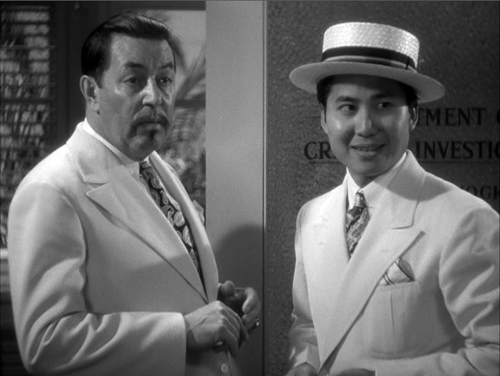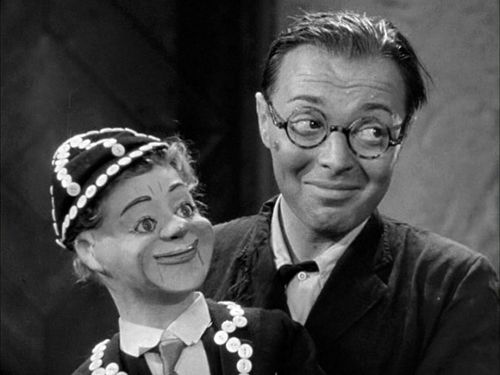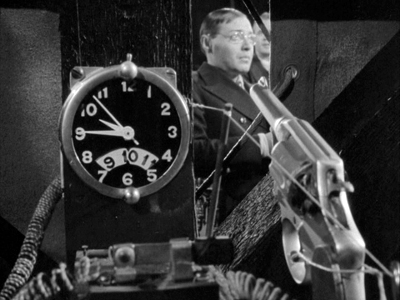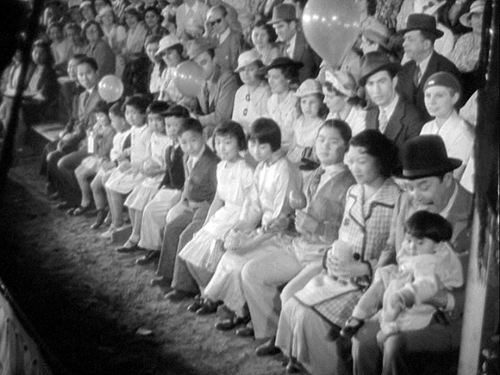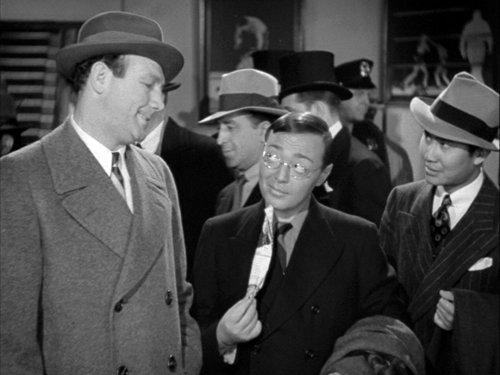Charlie, meet Kentaro
Friday | March 16, 2007 open printable version
open printable version
DB here:
Echoing an earlier virtual roundtable on this blog, I want to write about my two favorite B film series, now available in handsome DVD boxed sets. Both series were mounted at 20th Century-Fox, both were adapted from genre fiction, and both seem very much of their time: lots of exotic Orientalia, and probably too many middle-aged men in tiny mustaches and broad fedoras. But to my mind these films offer brisk, unpretentious entertainment, solidly crafted and surprisingly subtle. They also allow us to trace some changes in the ways movies were made across the 1930s.
There’s another reason for this blog. Tim Onosko, a friend of Kristin’s and mine, recently died after a battle with pancreatic cancer. Tim was an extraordinary figure, as you can find here. He was central to Madison film culture for forty years, and in his various creative activities, he shaped everything from The Velvet Light Trap to Tokyo Disneyland. He and his wife Beth also made a documentary, Lost Vegas: The Lounge Era. Tim and I enjoyed talking about the two series I’ll be mentioning. He loved these films, as he loved all films and popular culture generally, with a sharp-eyed dedication. So this is a small effort at an homage to Tim.
The Hawaiian and the Japanese
Charlie Chan, a Hawaiian police inspector of Chinese ancestry, became famous in a series of six novels by Earl Derr Biggers, from The House without a Key (1925) to The Keeper of the Keys (1932). Chan novels were brought to the screen at the end of the 1920s by Pathé and Universal, but for Behind That Curtain (1929) Fox took over the franchise. Warner Oland, a Swedish-born actor who had often played Asians, settled into the lead role in Charlie Chan Carries On (1931). He played Chan up through Charlie Chan at Monte Carlo (1937), then fled Hollywood under peculiar circumstances and went to Sweden, where he died soon afterward.
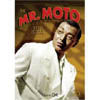 The Mr. Moto films overlapped with the Oland cycle. John P. Marquand introduced Moto in the novel No Hero (1935) and made him more central to four novels that followed. Again, Fox bought the rights and launched the film series with Thank You, Mr. Moto (1937). It starred Peter Lorre as the mysterious Japanese, and I think it’s fair to say that the role made him a Hollywood star. The series ran for eight installments, ending in 1939 with Mr. Moto Takes a Vacation.
The Mr. Moto films overlapped with the Oland cycle. John P. Marquand introduced Moto in the novel No Hero (1935) and made him more central to four novels that followed. Again, Fox bought the rights and launched the film series with Thank You, Mr. Moto (1937). It starred Peter Lorre as the mysterious Japanese, and I think it’s fair to say that the role made him a Hollywood star. The series ran for eight installments, ending in 1939 with Mr. Moto Takes a Vacation.
Each series echoed its mate. Tim claimed that in an early Chan, a character is reading a Moto story in the Saturday Evening Post, though I’ve never found that scene. When Charlie’s Number One Son turns up to help Moto in Mr. Moto’s Gamble (1938) it’s revealed that Charlie and Moto are old friends. There’s a more elegiac moment in Mr. Moto’s Last Warning (1939) when a theatre displays a poster for the Chan series—perhaps as well serving as an homage to the recently deceased Warner Oland. Despite Oland’s death, the Chan series continued until 1949, with Sidney Toler in the role, but with Lorre’s departure the Moto films ceased.
Having a Caucasian actor play an Asian protagonist was common at the time. Today, it seems condescending or worse, but we should recognize that the films featured Asian actors as well, often in significant roles. The most visible example is Keye Luke as Charlie’s highly Americanized son. Forever blurting out “Gosh, Pop!” Luke is a lively and likable presence.
Just as important, the portrayal of the detectives is remarkably free of racism. Charlie and Moto are clearly the quickest-witted characters, and both prove resourceful in all kinds of ways. Moto’s judo subdues thugs twice his size, and Charlie is up-to-date in the new technologies of detection.
The scripts go out of their way to show both men skilfully handling the prejudice they encounter. In Charlie Chan at the Opera (1936), a blatantly racist cop (William Demarest) who calls Charlie “Chop Suey” is mocked incessantly by everyone, most gently by Charlie. Moto excels at pretending to be the stereotypical Asian (“Ah, so!” “Suiting you?”). And both our protagonists are sympathetic to others who are in minorities. Charlie is notably unwilling to participate in guying black servants as the whites do, and Charlie Chan at the Circus (1936) shows his keen sympathy with the “freaks,” treating them with quiet courtesy. The Moto series presents a Japanese who doesn’t seem to share his country’s goal of ruling Asia. In Thank You, Mr. Moto, he enjoys a respectful friendship with a Chinese family of declining fortunes.
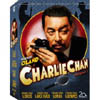 The Chan series features straightforward detection. A murder is committed, and either Charlie is in the vicinity or the police ask for his help. A young and innocent couple is involved, adding pressure for Charlie to solve the case. Another murder is likely to take place, and a few attempts are made on Charlie’s life before he comes to the solution. In traditional fashion he tends to assemble all the suspects at the climax before exposing the guilty party.
The Chan series features straightforward detection. A murder is committed, and either Charlie is in the vicinity or the police ask for his help. A young and innocent couple is involved, adding pressure for Charlie to solve the case. Another murder is likely to take place, and a few attempts are made on Charlie’s life before he comes to the solution. In traditional fashion he tends to assemble all the suspects at the climax before exposing the guilty party.
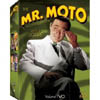 The Moto films aren’t as concerned with puzzles. Like the novels, they’re tales of international intrigue, involving smuggling, theft of archaeological treasures, and the like. There’s more violence and physical action, with shootouts and last-minute rescues. Moto Kentaro (his given name is visible only on his identity card) is a more shadowy presence than Charlie, often working under vague auspices. He’s either an agent of Interpol, a functionary of the Japanese government, or an exporter who takes up intrigue as a hobby. (1) In Mr. Moto’s Gamble, arguably the best of the series, he engages in old-fashioned detection involving murder during a boxing match. Unsurprisingly, the film was originally planned as a Chan vehicle, and it even includes Number One Son as Moto’s sidekick.
The Moto films aren’t as concerned with puzzles. Like the novels, they’re tales of international intrigue, involving smuggling, theft of archaeological treasures, and the like. There’s more violence and physical action, with shootouts and last-minute rescues. Moto Kentaro (his given name is visible only on his identity card) is a more shadowy presence than Charlie, often working under vague auspices. He’s either an agent of Interpol, a functionary of the Japanese government, or an exporter who takes up intrigue as a hobby. (1) In Mr. Moto’s Gamble, arguably the best of the series, he engages in old-fashioned detection involving murder during a boxing match. Unsurprisingly, the film was originally planned as a Chan vehicle, and it even includes Number One Son as Moto’s sidekick.
Looks and looking
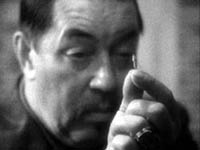
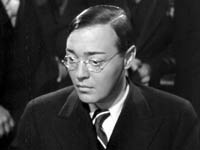
We can learn a lot by studying the two main actors’ performance styles. The plump Oland plays Chan as stolid but not ponderous. He floats across a room and gravely circulates among suspects, giving the films their deliberate pacing. Oland’s drawn-out delivery and pauses were due, people say, to his acute alcoholism, but he never seems to be struggling to find his lines. Charlie is at pains to be unobtrusive, modest, and tactful; his characteristic gesture is a simple one, letting the fingertips of one hand grasp one finger of the other.
He is a loving father, doting on his many children (all in tow in Charlie Chan at the Circus). Although Number One Son may exasperate him, you would go far in films to find as warm a portrayal of a father’s affectionate efforts to curb an impulsive boy. See Charlie Chan at the Olympics (1937) for the casual byplay between Charlie and Lee, now an art major and a member of the swimming team. Lee’s bubbling energy gives Charlie’s imperturbability even greater gravitas.
The short and slim Lorre plays Moto as a suave man-about-Asia, hand thrust casually into his trouser pocket. Moto is an art connoisseur, a graduate of Stanford (class of ‘21), and a master of many languages. Lorre, so easily caricatured at the time and now, hit on a brilliant idea: He didn’t give Moto stereotyped tricks of pronunciation. Unlike Oland, he didn’t usually drop articles or compress syntax.(2) Lorre just played the part in his lightly accented English, as he would in The Maltese Falcon and Casablanca. He added a soft-spoken delivery, a modest smile, and a trick he may have picked up from Marlene Dietrich–ending his sentences with a slight upward inflection, turning every statement into a polite question.
Reaction shots of suspects are a convention of these movies, but after several cuts show us everybody looking shifty, the reverse shots of our heroes show us that they miss none of this byplay. (3) Charlie is alert, but he hides his penetrating view behind a bland courtesy. As Moto, Lorre presents a more aggressive intelligence. Peering through round spectacles, those bug eyes, panic-stricken in M, can now become pensive or bore into a suspect. Charlie needs the force of law, but Moto, who usually acts alone, is dangerous by himself, and Lorre’s horror-show pedigree serves him well in giving his hero’s stare a sinister edge.
Listening and looking
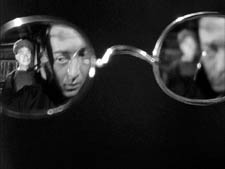
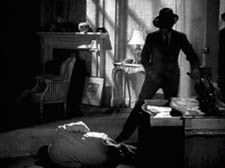
You can argue that Oland and Lorre, coming to their parts only a few years after sound had arrived, helped Hollywood develop a wider array of acting styles. We historians of Hollywood have rightly praised gabby comedies like Twentieth Century (1934) and It Happened One Night (1934) for finding a performance technique suited to sound films, particularly in the wake of technical improvements in acoustic recording. If movies had to talk, we think, they should really talk, fast and hard and heedlessly. In this church our Book of Revelations is His Girl Friday (1940).
Lorre and Oland, like Karloff and Lugosi, remind us of the virtues of being gentle, spacious, and deliberate. This isn’t a reversion to those hesitant, strangled mumblings of the earliest talkies. Rather, the movies’ plots surround our Asians with rapid-fire duels of cops and reporters, snapping out “Say!” and “Hiya, sister!” and “Watch it, wise guy!” and “Don’t be a sap!” Against clattering percussion Moto and Charlie deliver a melodic purr.
Some people still believe that in Citizen Kane Welles and Gregg Toland introduced American film to steep low angles, tight depth compositions, and noirish lighting. In The Classical Hollywood Cinema, I’ve argued that the Gothic, somewhat cartoonish look of Kane synthesized and amplified trends that were emerging during the 1930s. The Chan and Moto films are wonderful places to study these visual schemas.
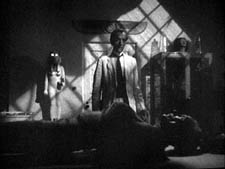
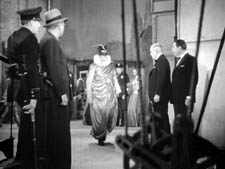 E
E
In Charlie Chan in Egypt (1935, above), cinematographer Charles G. Clarke (whom Kristin and I interviewed for the Hollywood book) offers flashy depth and silhouette effects, and nearly all the Chan films have moments of clever staging. Charlie Chan at the Opera, above, is particularly engrossing, with its huge set (recycled from the A-picture Café Metropole, 1937). The same film, incidentally, contains scenes of a fictitious opera, Carnival, composed by Oscar Levant. This was an ambitious gesture for a B film and looks forward to Bernard Herrman’s Salammbo sequences of Kane.
The Motos are even more remarkable. You want wild angles? Venetian-blind shadows? Telltale reflections in eyeglasses? Swishing bead curtains? Twisted expressionist décor? You’ve come to the right place.
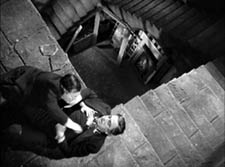
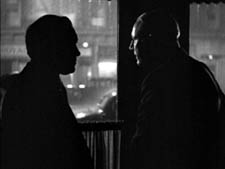
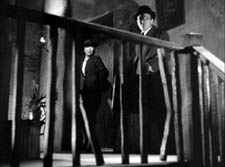
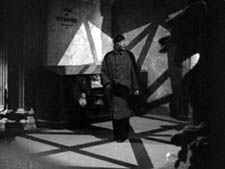
Some late thirties Fox sets seem to have been stored in Caligari’s Cabinet. Watching these films, it becomes clear that Kane applied the moody technique of crime and horror films to ambitious drama. One bold setup in Mr. Moto’s Gamble looks like a dry run for a Toland big-foreground composition (done here, as often in Kane, through special-effects). I like this shot so much I used it in Figures Traced in Light.
Yet all this creativity took place within severe constaints. These were B pictures, running under seventy minutes and shot in a month or so. Three or four would be released each year. They shamelessly used stock footage, leftover sets, and the same players in different roles from film to film. (Watch for Ray Milland, Ward Bond, and others on the way up.) The boys in the Fox cutting room seem to have enforced a remarkable uniformity: most of the Chans in these DVD sets, regardless of director, contain between 600 and 660 shots, while the faster-paced Motos average between four and six seconds per shot. The actors created hurdles too. Oland sank even further into drinking while the high-strung Lorre was addicted to morphine and periodically retired to sanitariums to recover. Those were the days; rehab wasn’t yet a matter for infotainment.
The Fox DVD boxes are model releases. The prints are well-restored (better on the second sets than the first) and filled with astute, informative supplements. We get a lot of detail about production matters, including why Oland left Hollywood. There is welcome biographical background on master minds like Sol Wurtzel and Norman Foster. I still want to know more about James Tinling, though; his direction of Mr. Moto’s Gamble and Charlie Chan in Shanghai (1935) belies his reputation as a hack.
“The cinema is not dangerous,” Moto reassures the Siamese tribesmen about to be filmed in Mr. Moto Takes a Chance (1938). Immediately, the woman who’s being filmed dies. The adventure begins. Who can resist movies like these? They have kept me happy since my childhood, when I watched them on Sunday afternoon TV. They can keep your children, and you, happy too.
For some good reading, see John Tuska, The Detective in Hollywood (Doubleday, 1978); Charles Mitchell, A Guide to Charlie Chan Films (Greenwood, 1999); Howard M. Berlin, The Complete Mr. Moto Film Phile: A Casebook (Wildside, 2005); and Stephen Youngkin, The Lost One: A Life of Peter Lorre (University Press of Kentucky, 2005).
For more on Charlie, click here. Charles Mitchell has a nice wrapup on Kentaro here.
(1) The involvement of an innocent romantic couple was a convention of slick-magazine fiction of the day (both the Chan and Moto novels were serialized in the Saturday Evening Post), and it recurs throughout mainstream detective fiction of the 1930s. Most writers of the period wrestled with the problem of how to make the couple interesting. See Carter Dickson/ John Dickson Carr’s short story, “The House in Goblin Wood,” for a brilliant handling of the device.
(2) As many commentators have noted, Charlie doesn’t speak pidgin English; he seems to be mentally translating. Interestingly, the generation gap is apparent here too, since Number One Son speaks peppy and perfect American slang.
(3) One hyperclever moment in Mr. Moto’s Gamble gives us the usual rapid-fire array of single shots of discomfited suspects but neglects to show us the real culprit.












